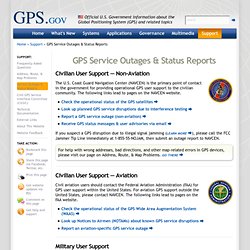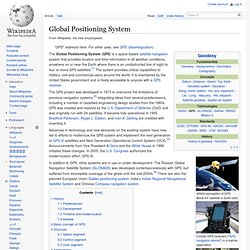

ConstellationStatus. GPS User Support. Civilian User Support — Non-Aviation The U.S.

Coast Guard Navigation Center (NAVCEN) is the primary point of contact in the government for providing operational GPS user support to the civilian community. Global Positioning System. Artist's conception of GPS Block II-F satellite in Earth orbit.

The Global Positioning System (GPS) is a space-based satellite navigation system that provides location and time information in all weather conditions, anywhere on or near the Earth where there is an unobstructed line of sight to four or more GPS satellites.[1] The system provides critical capabilities to military, civil and commercial users around the world. It is maintained by the United States government and is freely accessible to anyone with a GPS receiver. The GPS project was developed in 1973 to overcome the limitations of previous navigation systems,[2] integrating ideas from several predecessors, including a number of classified engineering design studies from the 1960s. GPS was created and realized by the U.S. Department of Defense (DoD) and was originally run with 24 satellites. USNO NAVSTAR Global Positioning System. The following Global Positioning System (GPS) information is obtained from the 1994 Federal Radionavigation Plan (FRP), prepared jointly by the Department of Defense (DoD) and the Department of Transportation (DoT) and other sources such as conferences, meetings and seminars.

The GPS is a DoD developed, worldwide, satellite-based radionavigation system that will be the DoD's primary radionavigation system well into the next century. The constellation consists of 24 operational satellites. The U.S. Air Force Space Command (AFSC) formally declared the GPS satellite constellation as having met the requirement for Full Operational Capability (FOC) as of April 27, 1995. Welcome to GPS.gov.